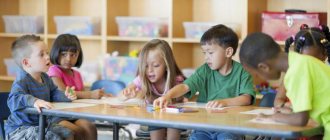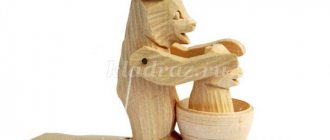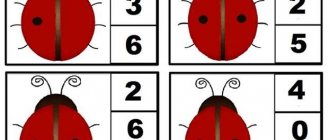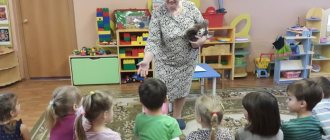Goal: To develop the ability to carefully examine the characters in a picture and answer questions about its content. Promote elements of creativity when trying to understand the content of the picture. To develop the ability to engage in storytelling together with the teacher. Develop memory and attention. Develop the ability to listen to each other and not interrupt.
Material: Painting.
Progress:
1 . Listen to the riddle.
Lives under the porch
Tail in a ring.
That's right, dog. Today we will look at the painting “Dog with Puppies”, and then we will come up with a story about a dog and its cubs.
Look and say who is depicted in the picture. What dog? (Big, black, shaggy, kind). What is the dog doing? (lies, rests, watches, guards, guards)
(The teacher encourages you to name the dog’s actions differently. The purpose of this activity is to guide the children so that they do not repeat the same words).
What does the first puppy do? (Lies next to mom). What is the second puppy doing? (Looks at the sparrows). Where does the food in the bowl come from in the picture? Who could have brought it? (Owner, daughter or son of the owner). What kind of food could be in the bowl? (Milk, meat, bones, sausage). Who else is depicted in the picture (birds, sparrows).
2. Attention game “Who is the most attentive?”
You have been looking at the picture for a long time, and now let’s see which of you is the most attentive?
- How many bowls are shown in the picture?
- What color is the dog?
- What birds are shown in the picture?
- Was the dog lying on a rug or on the floor?
- What did we see in the bowl?
(The picture is checked with the children’s answers after all the questions asked).
3. D/exercise “Make a story based on the picture.”
We carefully examined the picture, answered the questions, and now we will learn to write a story based on the picture. At home, tell your mom about the dog and her puppies. She will be very interested to listen. I will help you.
The painting shows a dog with... puppies. Big dog, what kind? (Shaggy, black). She has... (two puppies). One of them is called... (Tobik). The other's name is... (Tuzik). The puppies are small. What other ones? (Funny, fluffy). The dog and puppies had lunch. A caring owner named ... (Misha) put ... (pieces of meat) in a bowl. It was very... (tasty). There is nothing... (left) on the plate.
After a delicious lunch, the dog ... (lay down to rest). Tobik also ... (ate his fill) and ... (lay down next to his mother). Tuzik also did well... (ate), but he was very curious and began to... (watch the sparrows). We really ... (liked) the dog and puppies.
(The teacher sets the scheme of the story so that it prompts the child to describe and narrate. The teacher listens to several stories from the children, encouraging them not to repeat each other’s answers).
Dogs and puppies - educational notes. Read before coloring
Coloring pages with dogs and puppies are good because every child can create his friend exactly the way he wants. It’s easy to imagine a dog’s coloring, that is, its color, but how to convey its character?
Every dog and even a small puppy has its own personality. Our faithful friends accurately determine facial expressions and intonations, the good and bad mood of the owner. More than any other dog, they love children. The intelligence and intelligence of dogs is second only to monkeys and dolphins. They always understand us and love us so much that we cannot even imagine.
The dog coloring page allows children to imagine any color for any breed, as well as draw the dog's dreams. Yes, yes, dogs have dreams in which they think they are reliving the impressions of the day or hunting. Draw a cloud next to the dog and let the child figure out what his dog will dream about, maybe it will be a bone?
Can a dog coloring page bark?
It is very easy to draw barking in the dog coloring book. Children can easily draw small clouds themselves and write letters in them, and if you are given the task of drawing a dog barking, you will probably be surprised when you see how the child sees it. Don't be lazy to play this game.
It is interesting to know that dog barking is similar to wolf barking, only dogs bark more often than howl, and wolves do the opposite. Dogs bark when they see their owner or play with him - this is for joy. Aggressive barking can be heard when a dog encounters a stranger. If the sound is low, it means she is belligerent. A joyful bark is louder.
Preview:
Municipal autonomous preschool educational institution "Child Development Center - Kindergarten No. 3"
Summary of a lesson on speech development in secondary group No. 6
Summary of educational activities for speech development in the middle group “Storytelling based on the picture “Dog with puppies.”
Goal: continue to teach children to describe a picture in a certain sequence.
1. Educational: continue to teach how to carefully examine a picture, compose a story from it in 5-6 sentences with the help of a teacher. Continue teaching children to answer the teacher’s questions. Help children coordinate words in sentences.
2. Developmental: develop memory, attention, thinking,
3. Educational: to cultivate a caring attitude towards animals, a desire to take care of them; develop independence and confidence in your skills.
Materials and equipment: toy dog, sheets for breathing exercises, painting “Dog with puppies” (series “Pets” by S. A. Veretennikova), mnemonic table “Pets”, cut-out pictures from the series “Pets”.
Preliminary work: examination of illustrations depicting domestic animals; repetition of poems about autumn; reading poems and stories about animals; familiarization with the scheme.
(The teacher shows Dunno’s toy and speaks on his behalf.)
Dunno: Hello, guys! Look what a good day it is today.
Educator: Children, let's hold hands, give each other a good mood and say hello to our guest today. Guys, Dunno brought us a picture, he doesn’t know who is depicted here, should we help him?
Educator: Guys, can we tell from the picture? Can we describe it?
Educator: In order for our story to be correct and understandable, we will do breathing exercises.
Breathing exercises “Blow on leaves”
A strong wind suddenly blew
I. p. - exhale completely through your nose, drawing in your stomach and chest.
1 – take a full breath, protruding the stomach and ribs of the chest;
2 – hold your breath for 3-4 seconds;
3 – make the lips a tube, release the air.
Children sit on chairs.
Educator: Guys, guess the riddle:
Educator: Who is this? What does the animal look like? Parts of his body. Where does he live? What does it eat? What sounds does it make? What is the cub's name? How to protect yourself from enemies? How does it benefit people? In what fairy tales and cartoons does it appear? (Children's answers)
Physical education minute “Puppy”
Educator: Well done! Let's take a closer look at the picture that Dunno brought us. Children, first we need to come up with a name for this picture. (Individual answers.) The teacher listens to the children, corrects their answers, and explains that the title of the picture should not be very long.




